Market-Based Digital Platforms: Do They Primarily Support Post-Pandemic Creative Adaptation? †
Abstract
:1. Introduction
2. Material and Methods
2.1. Strategy
2.2. Interpersonal Communication
2.3. Incentives
2.4. Access
2.5. Quality Improvement
2.6. Digital Transactions
2.7. Methods
3. Results and Discussion
4. Conclusions
Author Contributions
Funding
Institutional Review Board Statement
Informed Consent Statement
Data Availability Statement
Acknowledgments
Conflicts of Interest
References
- Tortora, D.; Chierici, R.; Briamonte, M.F.; Tiscini, R. ‘I digitize so I exist’. Searching for critical capabilities affecting firms’ digital innovation. J. Bus. Res. 2021, 129, 193–204. [Google Scholar] [CrossRef]
- Motamarri, S.; Akter, S.; Hossain, A.; Dwivedi, Y.K. How does remote analytics empowerment capability payoff in the emerging industrial revolution? J. Bus. Res. 2022, 144, 1163–1174. [Google Scholar] [CrossRef]
- Yao, Q.; Baker, L.T.; Lohrke, F.T. Building and sustaining trust in remote work by platform-dependent entrepreneurs on digital labor platforms: Toward an integrative framework. J. Bus. Res. 2022, 149, 327–339. [Google Scholar] [CrossRef]
- Gebhardt, M.; Spieske, A.; Kopyto, M.; Birkel, H. Increasing global supply chains’ resilience after the COVID-19 pandemic: Empirical results from a Delphi study. J. Bus. Res. 2022, 150, 59–72. [Google Scholar] [CrossRef] [PubMed]
- Said, A.A. Laju Pertumbuhan Transaksi secara digital Meningkat Pada Januari, Produk Tumbuh 10%. Katadata.Co.Id; Katadata.Co.Id. 23 February 2022. Available online: https://katadata.co.id/agustiyanti/finansial/62162c334685b/laju-pertumbuhan-kredit-meningkat-pada-januari-kpr-tumbuh-10 (accessed on 23 February 2022).
- Hylland, O.M. Tales of temporary disruption: Digital adaptations in the first 100 days of the cultural Covid lockdown. Poetics 2021, 90, 101602. [Google Scholar] [CrossRef] [PubMed]
- Barker, V.L.; Luger, J.; Schmitt, A.; Xin, K.R. Corporate decline and turnarounds in times of digitalization. Long Range Plan. 2022, 102211. [Google Scholar] [CrossRef]
- Kandampully, J.; Bilgihan, A.; Bujisic, M.; Kaplan, A.; Jarvis, C.B.; Shukla, Y. Service transformation: How can it be achieved? J. Bus. Res. 2021, 136, 219–228. [Google Scholar] [CrossRef]
- Pratt, A.C. Toward circular governance in the culture and creative economy: Learning the lessons from the circular economy and environment. City Cult. Soc. 2022, 29, 100450. [Google Scholar] [CrossRef]
- Bilińska-Reformat, K.; Dewalska-Opitek, A. E-commerce as the predominant business model of fast fashion retailers in the era of global COVID 19 pandemics. Procedia Comput. Sci. 2021, 192, 2479–2490. [Google Scholar] [CrossRef]
- Bai, C.; Quayson, M.; Sarkis, J. COVID-19 pandemic digitization lessons for sustainable development of micro-and small- enterprises. Sustain. Prod. Consum. 2021, 27, 1989–2001. [Google Scholar] [CrossRef] [PubMed]
- Borthwick, M.; Tomitsch, M.; Gaughwin, M. From human-centred to life-centred design: Considering environmental and ethical concerns in the design of interactive products. J. Responsible Technol. 2022, 10, 100032. [Google Scholar] [CrossRef]
- Crawford, M.M.; Wright, G. The value of mass-produced COVID-19 scenarios: A quality evaluation of development processes and scenario content. Technol. Forecast. Soc. Chang. 2022, 183, 121937. [Google Scholar] [CrossRef] [PubMed]
- Dartnell, L.R.; Kish, K. Do responses to the COVID-19 pandemic anticipate a long-lasting shift towards peer-to-peer production or degrowth? Sustain. Prod. Consum. 2021, 27, 2165–2177. [Google Scholar] [CrossRef]
- Gancarczyk, M.; Gancarczyk, J. Proactive international strategies of cluster SMEs. Eur. Manag. J. 2018, 36, 59–70. [Google Scholar] [CrossRef]
- Kesa, D.D.; Pranita, D. MSME Development Strategy for Providing Information through Central Banking Microsite Web Based. J. Phys. Conf. Ser. 2021, 1783, 012052. [Google Scholar] [CrossRef]

| Variable | Cronbach Alpha (α) | Conclusion |
|---|---|---|
| Interpersonal communication (X1) | 0.740 | Reliable |
| Incentives (X2) | 0.669 | Reliable |
| Access (X3) | 0.689 | Reliable |
| Quality (X4) | 1.000 | Reliable |
| Strategy(Y) | 0.515 | Reliable |
| Coefficients a | ||||||
|---|---|---|---|---|---|---|
| Model | Unstandardized B | Coefficients Std.Error | Standardized Coefficients Beta | t | Sig. | |
| 1 | (Constant) | 2.390 | 1.839 | 1.300 | 0.203 | |
| Interpersonal Communication (X1) | 0.320 | 0.119 | 0.422 | 2.691 | 0.011 | |
| Incentives(X2) | 0.088 | 0.134 | 0.071 | 0.655 | 0.517 | |
| Access(X3) | 0.554 | 0.160 | 0.496 | 3.462 | 0.002 | |
| Quality(X4) | –0.320 | 0.331 | –0.122 | –0.968 | 0.340 | |
| ANOVA a | ||||||
|---|---|---|---|---|---|---|
| Model | Sum of Squares | df | Mean Square | F | Sig. | |
| 1 | Regression | 79.976 | 4 | 19.994 | 15.740 | 0.000 b |
| Residual | 41.919 | 33 | 1.270 | |||
| Total | 121.895 | 37 | ||||
| Model Summary | ||||
|---|---|---|---|---|
| Model | R | R Square | Adjusted R Square | Std, Error of the Estimates |
| 1 | 0.810 a | 0.656 | 0.614 | 1.127 |
Disclaimer/Publisher’s Note: The statements, opinions and data contained in all publications are solely those of the individual author(s) and contributor(s) and not of MDPI and/or the editor(s). MDPI and/or the editor(s) disclaim responsibility for any injury to people or property resulting from any ideas, methods, instructions or products referred to in the content. |
© 2023 by the authors. Licensee MDPI, Basel, Switzerland. This article is an open access article distributed under the terms and conditions of the Creative Commons Attribution (CC BY) license (https://creativecommons.org/licenses/by/4.0/).
Share and Cite
Kesa, D.D.; Lee, C.W. Market-Based Digital Platforms: Do They Primarily Support Post-Pandemic Creative Adaptation? Proceedings 2022, 83, 61. https://doi.org/10.3390/proceedings2022083061
Kesa DD, Lee CW. Market-Based Digital Platforms: Do They Primarily Support Post-Pandemic Creative Adaptation? Proceedings. 2022; 83(1):61. https://doi.org/10.3390/proceedings2022083061
Chicago/Turabian StyleKesa, Deni Danial, and Cheng Wen Lee. 2022. "Market-Based Digital Platforms: Do They Primarily Support Post-Pandemic Creative Adaptation?" Proceedings 83, no. 1: 61. https://doi.org/10.3390/proceedings2022083061
APA StyleKesa, D. D., & Lee, C. W. (2022). Market-Based Digital Platforms: Do They Primarily Support Post-Pandemic Creative Adaptation? Proceedings, 83(1), 61. https://doi.org/10.3390/proceedings2022083061







